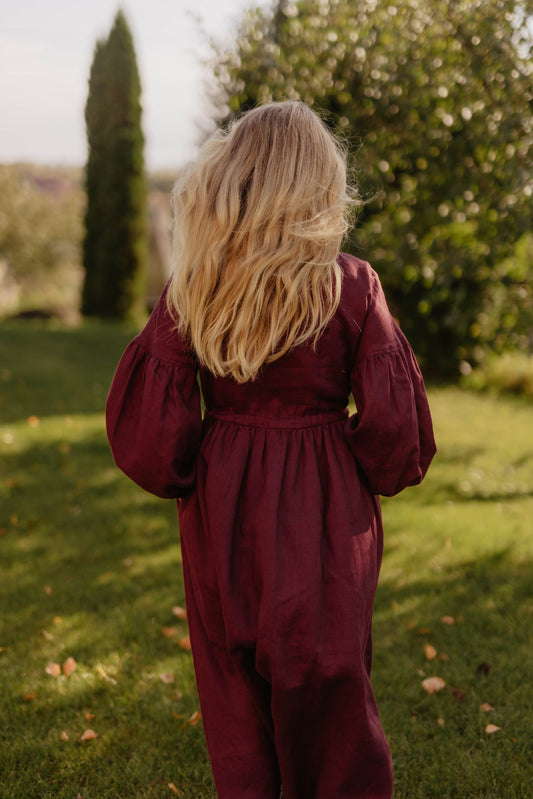
More Than Just Linen: What Mystical Powers Does Linen Hold?
Share
How a Simple Fabric Became A Symbol in Culture and Mythology
Welcome to Laumė linen, where we are passionate about linen and its amazing qualities - one of the oldest and most versatile fabrics in the world. It is made from the fibers of the flax plant, which can grow in various climates and soils. A fabric that is durable, breathable, and easy to dye, making it suitable for various purposes and occasions. We have a great article that explains the whole process of making linen. Even though the western cultures have forgotten about this fabric it has recently made a strong comeback. But did you know that linen is not just a practical material; it is also a magical one. Linen has been associated with various cultural and mythological traditions, especially in the regions of Lithuania, Scandinavia, and Norse lands. In this article, we will explore some of the fascinating stories and beliefs that surround linen and its role in these cultures.

Gift from the Goddesses
One of the most common themes in the folklore of linen is that it was a gift from the goddesses, who taught humans how to cultivate, process, and use it. In Lithuanian folklore, linen was a gift from the goddess Laima, who was the patroness of fate, childbirth, and weaving. Laima taught women how to grow, spin, and weave linen, and blessed them with good fortune and happiness. She also wore a linen dress that had the symbols of the sun, moon, and stars on it representing the beyond- fate.
In Norse mythology, linen was used by the goddess Frigg, who was the patroness of weaving, marriage, and motherhood. Frigg had a special linen distaff that she used to spin the threads of fate for all living beings. She also used her linen cloth to make oaths and contracts with other gods and creatures. Linen was also a gift that Frigg gave to her son Baldr, who was the god of light and joy. She made him a linen shirt that was supposed to protect him from harm, but it failed to do so when he was killed by a mistletoe dart - the one element he was vulnerable to. That was a tragic story, but it shows how much Frigg loved her son and how much she trusted linen.

Protection from Evil and a Source of Good Luck
Another common theme in the folklore of linen is that it was a material that could ward off evil and attract good luck. Linen was used to make protective charms, such as the solvända (sun turner), a linen cloth that was embroidered with a sun motif and hung on the window to catch the sun’s rays and keep away the darkness. It was also used to make festive decorations, such as the julbock (Yule goat), a linen figure that was stuffed with straw and placed under the Christmas tree to bring prosperity and health.
Linen was also a part of the midsummer celebration, which was called Rasos or Joninės in Lithuania. It was used to make wreaths, garlands, and bonfires that were lit on the night of June 23rd to honor the sun god Perkūnas and the goddess of love and beauty Milda. A magical way to celebrate the longest day in the year, when darkness of the night is only a few hours long. Linen was also used to make magic spells, such as throwing a linen cloth over a well or a pond to see one’s future spouse or throwing a linen thread over one’s shoulder to find out one’s destiny. Would you like to find out your fate that way?

Symbol of Purity and Fertility
A third common theme in the folklore of linen is that it was a symbol of purity and fertility and was used throughout the pivotal parts of one's life. Linen was used to make bridal gowns, veils, and bed sheets that were meant to ensure a happy and fruitful marriage. It was also used to make baby clothes, blankets, and diapers that were meant to protect the newborn from harm and illness. Not only that, it was also given as a gift to newlyweds and new parents to wish them well.
Linen was also a material that could communicate with humans and nature. It was believed to have a soul and a voice that could express its feelings and desires. And thus it could also sense the mood and character of its owner and react accordingly. For example, if the owner was kind and gentle, linen would be soft and smooth; if the owner was cruel and harsh, linen would be rough and coarse. What do you think your linen would feel like? Not only that linen could also interact with other natural elements, such as water, fire, wind, and earth. For example, if linen was washed in clean water, it would become white and shiny; if linen was burned in fire, it would turn into ashes that could fertilize the soil- giving a better harvest next year.

A Connection with Culture and Mythology
Scandinavian folklore is the collection of folktales, legends, superstitions, and customs that originated from the rural communities of Denmark, Norway, Sweden, Iceland, and Finland. These stories reflect the beliefs and values of the people who lived close to nature and faced various challenges and hardships.
One of the most common themes in Scandinavian folklore is the presence of supernatural beings such as trolls, elves, fairies, dwarves, giants, witches, and spirits. These creatures often interacted with humans in various ways: sometimes helping them, sometimes harming them, sometimes playing tricks on them. Linen played an important role in many stories involving these beings, as it was believed to have protective and magical properties. For example:
- In Norway, it was said that if you wore a linen shirt inside out, you could see through the illusions created by trolls and avoid being captured or enchanted by them.
- In Sweden, it was said that if you hung a linen cloth over your door or window, you could ward off evil spirits and prevent them from entering your home or harming your family.
- In Denmark, it was said that if you buried a linen cloth with a silver coin under your doorstep, you could attract good luck and prosperity to your household.
- In Iceland, it was said that if you wrapped a linen cloth around your head, you could enhance your psychic abilities and communicate with the hidden folk (elves).
These examples show how linen was considered a powerful material in Scandinavian folklore, symbolizing protection, luck, and wisdom. It also shows how linen was used as a tool for interacting with the supernatural realm, which was often seen as a source of both danger and opportunity.
To sum it all up
Linen is more than just a fabric; it is a cultural and mythological treasure. A fabric that has been woven into the stories and beliefs of various peoples for centuries, reflecting their values and aspirations. A gift from the goddesses, a protection from evil, a source of good luck, a symbol of purity and fertility, and a connection with culture and mythology. Linen is a magic that we can touch and feel, and that can touch and feel us back. It is truly a part of our history and our identity. That is why at Laumė linen, we are proud to offer you handmade linen kids bedding and home accessories that are inspired by the traditions and legends of linen. We hope that you will enjoy our products and experience the magic and mystical powers of linen for yourself. Thank you for choosing Laumė linen, where linen is not just a fabric, but a way of life.



